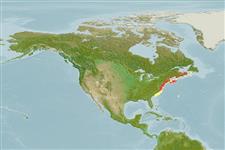Common names from other countries
分类 / Names
俗名 | 同种异名 | Catalog of Fishes(属, 种) | ITIS | CoL | WoRMS | Cloffa
Environment: milieu / climate zone / depth range / distribution range
生态学
海洋; 淡水; 半咸淡水 底中水层性; 溯河洄游 (Ref. 51243); 深度上下限 0 - 10 m (Ref. 7251). 溫帶; 10°C - 33°C (Ref. 121663); 50°N - 32°N, 96°W - 59°W
North America: Atlantic Slope drainages from St. Lawrence drainage in Quebec, Canada south to Savannah River in Georgia, USA. Transplanted to Great Lakes (except Superior) and Ohio-Missouri-Mississippi river systems of mid-western USA; elsewere as far west as Colorado, USA.
北美洲: 在加拿大魁北克的聖勞倫斯- 安大略湖的流域在美國南卡羅萊那州南至 Peedee 河。
大小 / 重量 / 年龄
Maturity: Lm ? range ? - ? cm
Max length : 58.0 cm TL 雄鱼/尚未辨别雌雄; (Ref. 86798); common length : 13.5 cm TL 雄鱼/尚未辨别雌雄; (Ref. 12193); 最大体重: 2.7 kg (Ref. 120584); 最大年龄: 16 年 (Ref. 72462)
Occurs in fresh, brackish and coastal waters (Ref. 7251). Inhabits pools and other quiet-water areas of medium to large rivers, usually over mud (Ref. 86798). Neither anterolateral glandular groove nor venom gland is present (Ref. 57406).
出现于淡水、半咸淡水与沿岸水域。 (参考文献 7251) 主要地发现于半淡咸水了,但是中型到大型河川的常见于水池与其他静止的水域区域,通常在泥上面。 既不是前外侧的腺凹槽也不是毒液腺存在.(参考文献 57406)
Assuming same mode of reproduction as in M. saxatilis.北美洲: 在加拿大魁北克的聖勞倫斯- 安大略湖的流域在美國南卡羅萊那州南至 Peedee 河。
Page, L.M. and B.M. Burr, 2011. A field guide to freshwater fishes of North America north of Mexico. Boston : Houghton Mifflin Harcourt, 663p. (Ref. 86798)
CITES (Ref. 128078)
Not Evaluated
人类利用
渔业: 低经济; 游钓鱼种: 是的; 水族馆: 公众的水族馆
工具
特别资料
下载 XML
网络资源
Estimates based on models
Preferred temperature (Ref.
115969): 4.7 - 18.2, mean 10.2 (based on 64 cells).
Phylogenetic diversity index (Ref.
82804): PD
50 = 0.5781 [Uniqueness, from 0.5 = low to 2.0 = high].
Bayesian length-weight: a=0.00447 (0.00185 - 0.01077), b=3.13 (2.91 - 3.35), in cm Total Length, based on LWR estimates for this (Sub)family-body shape (Ref.
93245).
营养阶层 (Ref.
69278): 3.1 ±0.35 se; based on food items.
回复力 (Ref.
120179): 低的, 最小族群倍增时间4.5 - 14 年 (K=0.07-0.13; tmax=7(?)).
Fishing Vulnerability (Ref.
59153): High to very high vulnerability (69 of 100).
Climate Vulnerability (Ref.
125649): Moderate to high vulnerability (52 of 100).
